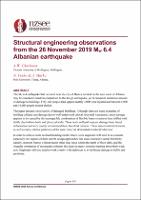Structural engineering observations from the 26 November 2019 M6.4 Albanian earthquake

Download
Date
2020-04-22Authors
Charleson, Andrew
Vesho, N.
Marku, A.
Metadata
Show full item recordAbstract
The Mw 6.4 earthquake that occurred near the city of Durres, located on the west coast of Albania, may be considered small in comparison to the design earthquake, yet it caused an enormous amount of damage to buildings. Fifty-one people died, approximately 3,000 were injured and between 5,000 and 14,000 people needed shelter.
The paper presents observations of damaged buildings. Although there are many examples of building collapse and damage due to well-understood critical structural weaknesses, most damage appears to be caused by the incompatible combination of flexible frame structures then infilled with brittle clay hollow-brick and plastered walls. These walls suffered in-plane damage from lateral deformation and were mostly unrestrained from face-load collapse. These non-structural elements, as well as many interior partitions of the same material, dominated structural behaviour.
In order to achieve more resilient buildings in the future, local engineers will need to re-evaluate especially two aspects of their current design approaches that cause excessive lateral flexibility; namely, moment frames without beams other than those within the depth of floor slabs, and the irregular orientation of rectangular columns that leads to many columns bending about their weak axis. Engineers will also need to work closely with architects to avoid future damage to infills and partitions.
